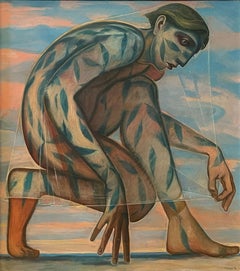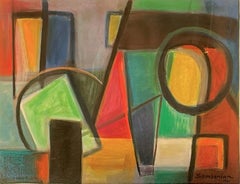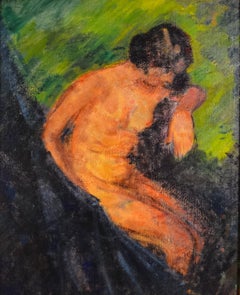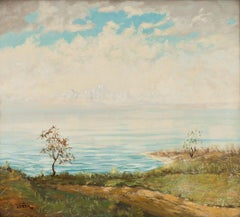Lincoln Glenn Art
1980s Abstract Expressionist Abstract Paintings
Canvas, Oil
1990s Surrealist Figurative Paintings
Canvas, Oil
1980s Abstract Geometric Abstract Drawings and Watercolors
Paper, Oil
1910s American Impressionist Figurative Paintings
Canvas, Oil
1910s Ashcan School Nude Paintings
Canvas, Oil
1920s Hudson River School Landscape Paintings
Canvas, Oil
1950s American Impressionist Landscape Paintings
Oil, Board
1990s Abstract Abstract Prints
Paper, Lithograph
1980s Pop Art Portrait Paintings
Board, Pastel
Early 2000s Contemporary Figurative Paintings
Oil, Canvas
1910s American Impressionist Landscape Paintings
Oil, Canvas
1980s American Modern Landscape Paintings
Canvas, Oil, Board
Mid-20th Century Realist Figurative Paintings
Granite
1970s Feminist Abstract Paintings
Mixed Media, Board
1960s Figurative Drawings and Watercolors
Paper, Pigment
Early 1900s Modern Figurative Prints
Paper, Etching
1840s Hudson River School Figurative Paintings
Paper, Watercolor
1870s Tonalist Landscape Drawings and Watercolors
Paper, Pencil
1930s American Realist Landscape Paintings
Canvas, Oil, Tempera
Early 20th Century American Impressionist Landscape Paintings
Canvas, Oil
1920s Tonalist Landscape Paintings
Canvas, Paint, Oil
Mid-20th Century American Realist Landscape Paintings
Canvas, Paint, Oil
1920s Feminist Portrait Drawings and Watercolors
Paper, Watercolor
1880s Hudson River School Landscape Paintings
Canvas, Paint, Oil
1970s Contemporary Figurative Paintings
Oil, Panel
20th Century American Modern Still-life Paintings
Canvas, Oil
20th Century More Art
Animal Skin
Mid-20th Century Abstract Expressionist Mixed Media
Oil, Watercolor, Gouache
1890s Art Nouveau Figurative Drawings and Watercolors
Paper, Ink, Watercolor
19th Century American Impressionist Landscape Paintings
Oil, Panel
19th Century Hudson River School Animal Paintings
Canvas, Oil
1950s Folk Art Figurative Paintings
Canvas, Oil
1940s American Realist Landscape Paintings
Paper, Watercolor
Early 20th Century Tonalist Landscape Paintings
Canvas, Oil
2010s Folk Art Landscape Paintings
Oil, Board
1980s Contemporary Abstract Sculptures
Cotton, Thread, Glass, Wood
Mid-19th Century Figurative Paintings
Oil, Wood Panel
1980s American Modern Landscape Drawings and Watercolors
Paper, Pastel
Mid-20th Century American Realist Landscape Paintings
Canvas, Paint, Oil
1980s Abstract Expressionist Abstract Paintings
Canvas, Oil
2010s Abstract Expressionist Abstract Paintings
Canvas, Oil
Mid-20th Century American Modern Abstract Paintings
Ink, Gouache, Board
1970s Feminist Abstract Paintings
Mixed Media, Board
1990s Contemporary Landscape Paintings
Canvas, Oil
1970s Contemporary Landscape Drawings and Watercolors
Paper, Watercolor
Late 19th Century Portrait Paintings
Canvas, Oil
Early 20th Century Impressionist Figurative Paintings
Oil, Board
1870s Hudson River School Interior Paintings
Canvas, Oil
Early 1900s American Impressionist Landscape Paintings
Oil, Board
Mid-20th Century American Impressionist Landscape Paintings
Oil, Panel
Early 20th Century American Impressionist Landscape Paintings
Oil, Panel, Canvas
1870s Hudson River School Landscape Paintings
Canvas, Oil
1920s Pointillist Landscape Paintings
Canvas, Oil
Early 20th Century Tonalist Landscape Paintings
Canvas, Oil
Early 20th Century American Impressionist Landscape Paintings
Canvas, Oil
Early 20th Century American Impressionist Landscape Paintings
Oil, Board
Mid-20th Century American Realist Landscape Paintings
Canvas, Oil
1850s Hudson River School Landscape Paintings
Canvas, Oil
Late 19th Century Hudson River School Landscape Paintings
Canvas, Oil
1910s American Impressionist Landscape Paintings
Canvas, Oil




